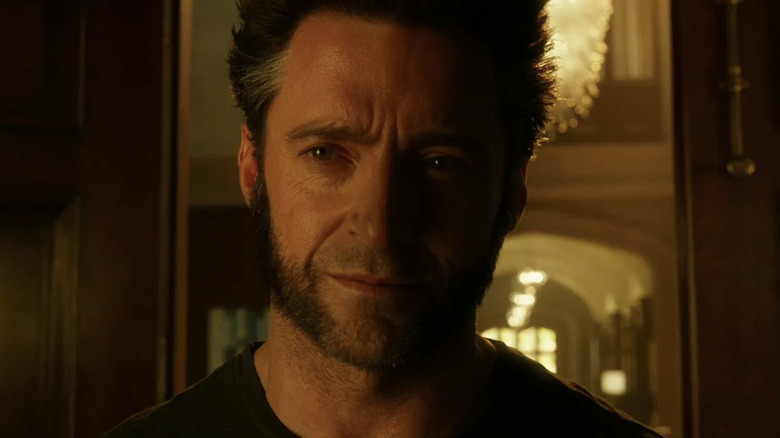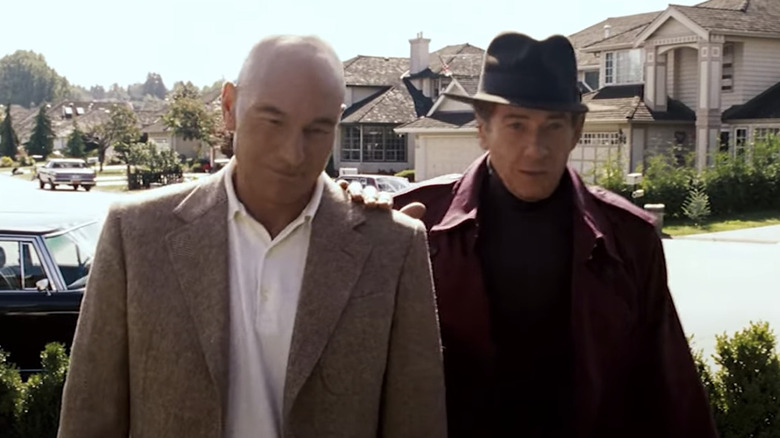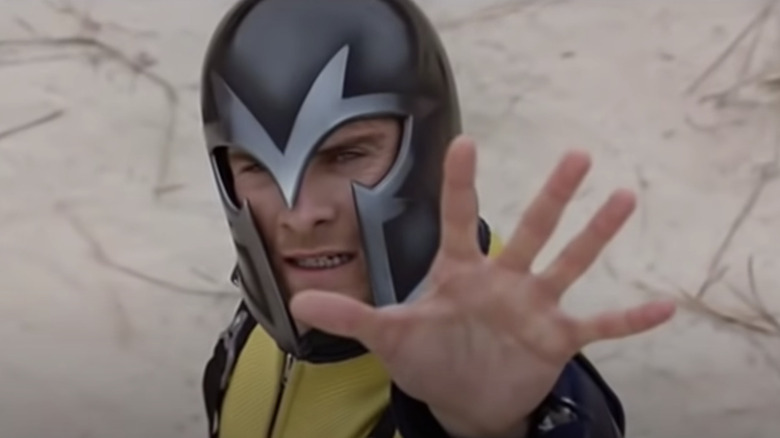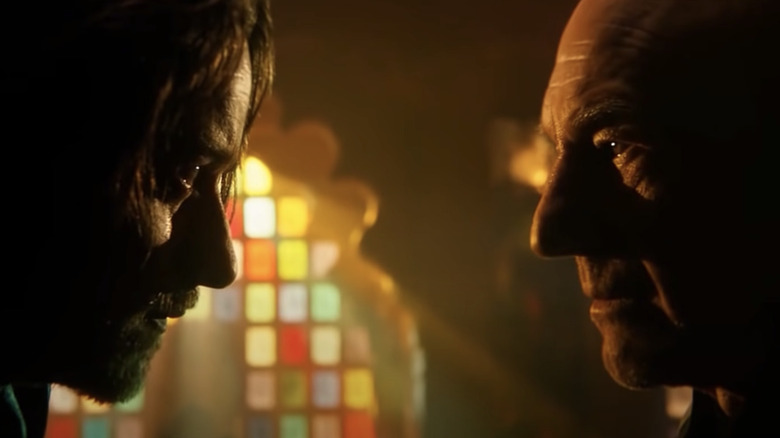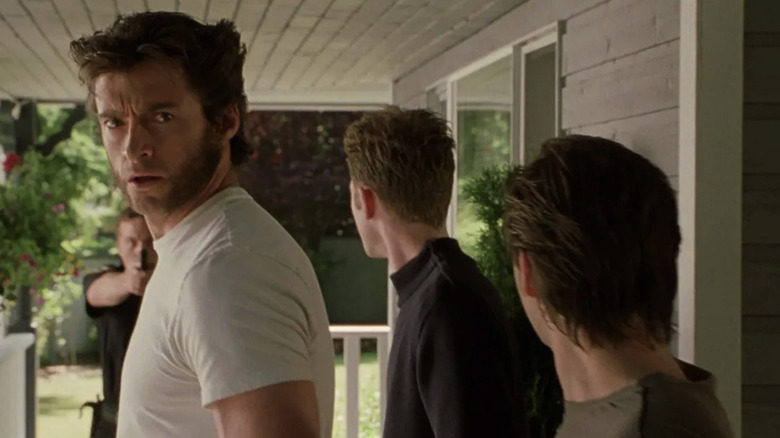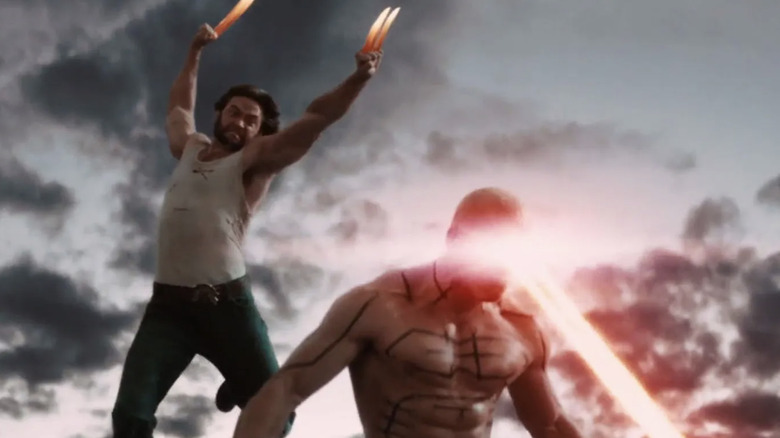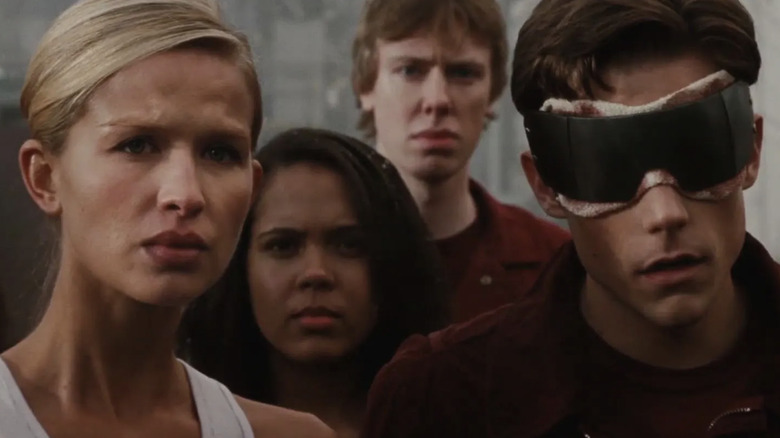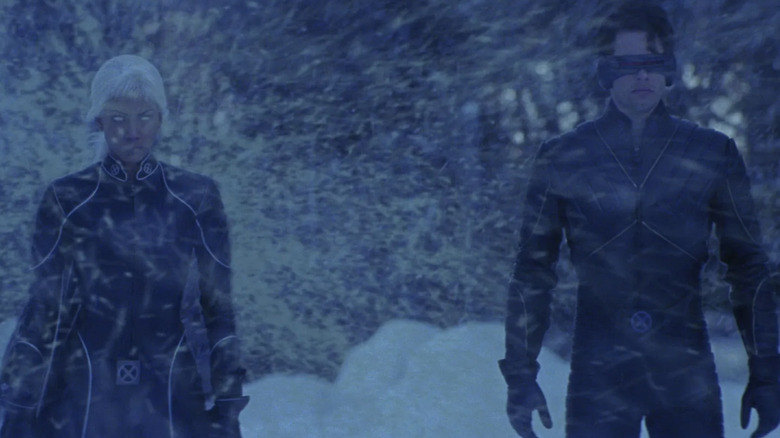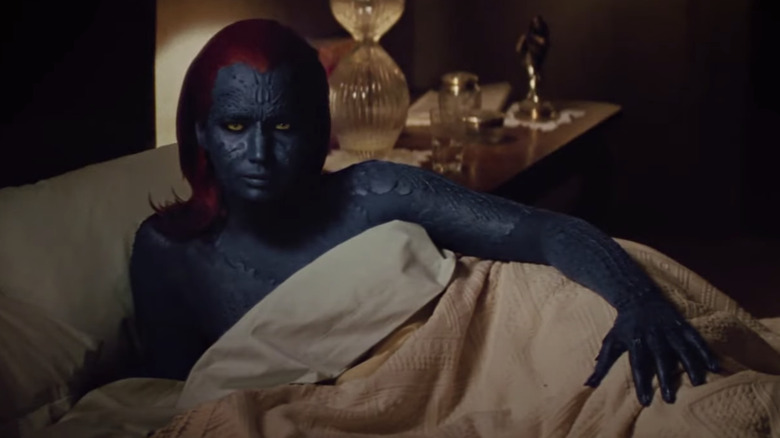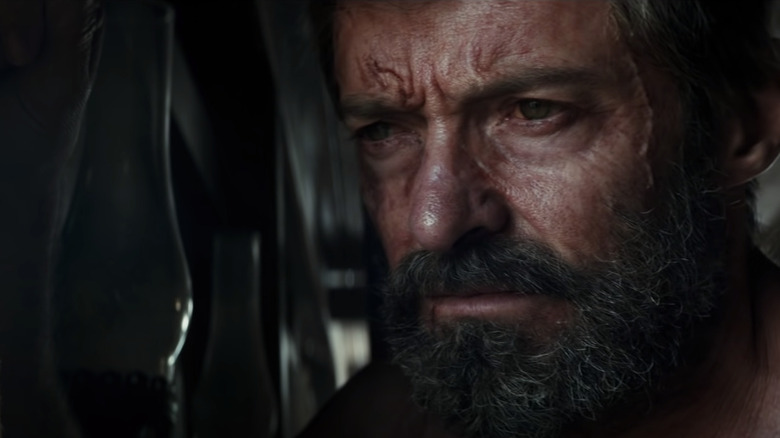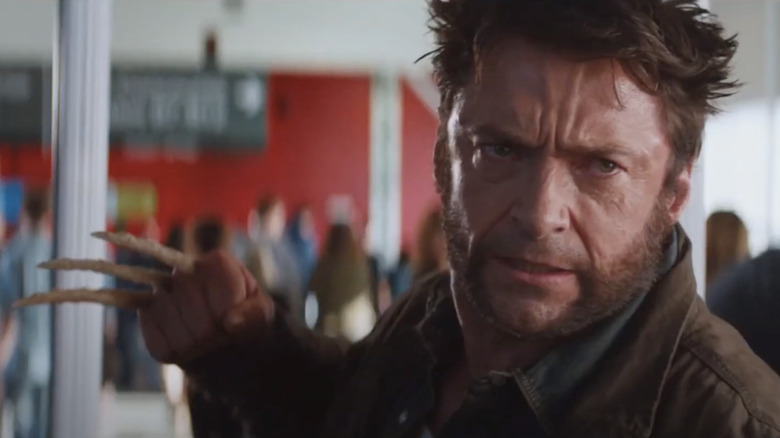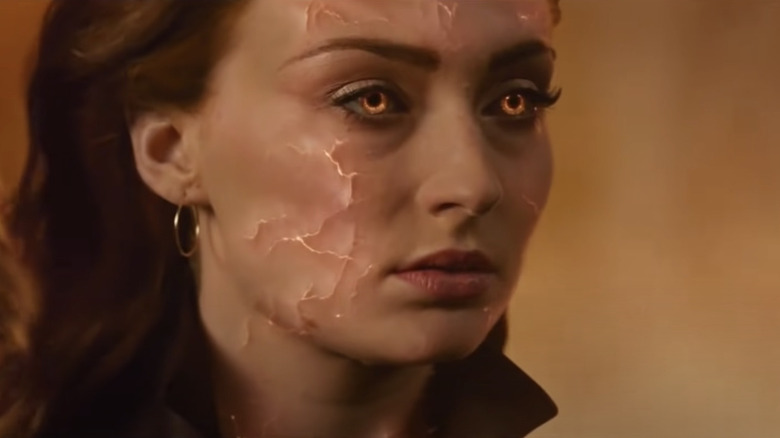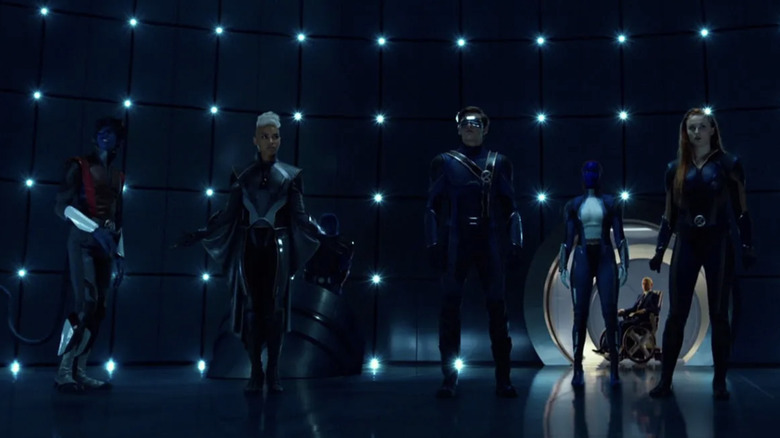These Things Happen In Every Single X-Men Movie
In the early 2000s, the "X-Men" film series was the first big Marvel superhero franchise to really take off. The "X-Men" films were produced by 20th Century Fox Studios, not Marvel Studios; therefore, they exist outside of the MCU. That disconnect never stopped X-fans from flocking to the theaters to watch the next installment. Whether your favorite character is Wolverine, Jean Grey, Magneto, or Mystique, the films provide you with interesting, though not always faithful, adaptations of Marvel's greatest mutants.
Over the course of the first "X-Men" trilogy, the four prequel movies, and the "Wolverine" trilogy, there are some clear recurring elements that kept bringing us back for more. To faithfully chronicle them all, we put together the following list of things that happen in every "X-Men" film, not counting the two "Deadpool" movies, which don't really follow the same timeline, and 2020's "The New Mutants."
Here, we'll take a look at how these recurring themes helped the "X-Men" series stay viable for so long. Of course, now that Disney owns 20th Century Fox, we're presumably in for a complete X-Men reboot set in the MCU, with new actors playing all our favorite mutants. But hey, for the time being, at least we've still got the old movies!
A standoff between Xavier and Magneto
If you've ever watched an "X-Men" film, you've seen a confrontation between Professor Charles Xavier, aka Professor X, and Erik Lehnsherr, aka Magneto. As the respective leaders of the X-Men and the Brotherhood, these two are the heaviest hitters on their respective sides of the mutant morality spectrum (with the exception of Jean Grey) and constantly face each other in battle. Sometimes the warfare between Xavier and Magneto is philosophical, and sometimes it's a bit more physical. Whether they're played by Patrick Stewart and Ian McKellen or James McAvoy and Michael Fassbender, Professor X and Magneto are the truest staples of the "X-Men" movie universe, even more than Hugh Jackman's Wolverine.
The "X-Men" films really lucked out in casting these four men as the younger and older versions of the iconic frenemies. All four bring lots of depth to their respective roles and truly enrich the "X-Men" story. Even the dumpster fire that is 2019's "Dark Phoenix" is slightly improved by the dynamic between Charles and Erik. While they might not face off in the "Wolverine" trilogy, they appear alongside one another at the end of "The Wolverine." Their rocky friendship — chronicled over seven films — is absolutely worth mentioning here.
Fear of mutants
A recurring theme in many "X-Men" comic books is people fear what they don't understand, and what they don't understand is mutants. While heroes like the Fantastic Four and the Avengers are generally cheered on by super-powerless bystanders, the X-Men are ridiculed and criticized for their strange differences. The double standard has been addressed over the years, both in comics and in various commentaries. But whether or not there's an explanation for Marvel society's seemingly paradoxical treatment of mutants, the films don't have to worry about it. Thanks to intellectual property rights, the only superpowered beings walking around in 20th Century's "X-Men" movies are mutants.
In the "X-Men" films, the abilities of people like Rogue and Wolverine can hurt or even kill someone as easily as a touch. Professor X and Jean Grey can invade people's minds. Cyclops would kill everyone he looked at if not for his special visor. It's clear that mutants can be dangerous. In fact, in 2006's "X-Men: The Last Stand," Worthington Labs comes up with a cure for the mutant gene, offering it to any mutant who wishes to be normal. Even after the events of 2014's "X-Men: Days of Future Past" reshape the timeline, mutants are still discriminated against in 2017's "Logan." It seems that no matter the time, or the X-Men's efforts, some people will always be afraid.
Inconsistent aging
This is less of a recurring theme and more like a recurring inconsistency. The "X-Men" films, particularly the prequel series, feature characters who look the exact same throughout multiple in-story decades. It's a little distracting.
While we'll give characters like Wolverine and Mystique a pass given the nature of their mutant abilities, there's no excuse for characters like Alex Summers (Lucas Till) not appearing to age a day in the 10 years between the events of 2011's "X-Men: First Class" and "Days of Future Past." The same goes for the entire cast of 2016's "X-Men: Apocalypse" who barely seem to grow at all by the time of "Dark Phoenix," set nearly a decade later.
Of course, the worst offenders are the James McAvoy and Michael Fassbender incarnations of Professor X and Magneto, who look like handsome 30-somethings starting from "First Class," which takes place in the 1960s, all the way through to "Dark Phoenix," which takes place in the 1990s. That's a three-decade difference, but the way Charles and Erik look might make you assume the stories of each film only happen a few years apart.
And let's not forget that creepy digitally de-aged Xavier from the 1980s at the end of "X-Men Origins: Wolverine." Unfortunately for 2009 moviegoers, Hollywood hadn't yet developed the technology to make Patrick Stewart look as young and spry as James McAvoy.
Philosophically compelling themes
If there's one thing that we can say the "X-Men" movies do incredibly well, it's that they always feature an interesting battle of ideals. You might think that the themes of peace versus war or love versus hate might get stale after a while, but they always feel fresh.
The first two films directed by Bryan Singer, especially 2003's "X2: X-Men United," play with the idea of whether Homo sapiens and Homo superior (that is, humans and mutants) can coexist in peace. Professor X faithfully plays the part of a mutant integrationist in the spirit of Martin Luther King Jr. while Magneto serves as a mutant separatist in the spirit of Malcolm X. The tension between them is electric, and their difference of philosophical opinion makes for some compelling conflicts.
These ideals continue into the "Wolverine" trilogy, though as these movies progress, the message begins to change. While "X-Men Origins: Wolverine" pits Logan and his half-brother Sabretooth against each other in a fashion vaguely similar to Professor X and Magneto, Wolverine's memory loss renders most of the story moot. By the time the future events of "Logan" come around, our titular hero is on a new journey. While he's haunted by his past, the eponymous mutant is forced to fight for the future, learning what it means to be a father and a hero.
Mutant-on-mutant violence
For all of Magneto's talk about how humans put mutants down, hate them, experiment on them, and hope to kill them, we see mutants fight each other just as often as humans in the "X-Men" movies. Whether it's the X-Men versus the Brotherhood in 2000's "X-Men" and "The Last Stand," their battle against Sebastian Shaw (Kevin Bacon) in "First Class," or the ancient Egyptian mutant Apocalypse (Oscar Isaac) in "Apocalypse," mutants do more than their fair share of fighting other mutants.
Sure, the X-Men and Magneto team up to combat their own extinction in the most critically acclaimed "X-Men" films ("X2" and "Days of Future Past") but even those movies feature some great superpowered-up fight sequences. All of the "Wolverine" films include Logan facing off against a mutant foe toward the end, and the X-Men battle Jean Grey herself on multiple occasions. There's no doubt that watching some of the most powerful mutants face off against one another is pretty exciting. It's no wonder that the "X-Men" films make it a point to include some significant superpowered slobber-knockers.
Inconsistent timelines
The most frustrating thing about the "X-Men" series is the often confusing and contradictory nature of its established timeline. While there's nothing wrong with telling a good story, playing fast and loose with your own continuity to do so is lazy and potentially alienating to longtime viewers. Even aside from the few characters who never seem to visibly age, there are some other elements that just don't make sense.
For one example, Professor X claims he met Magneto when he was 17 in "X-Men" but when we see their meeting in "First Class," they're adults. Similarly, according to the timeline established in "First Class," Mystique and Xavier grew up together. The original trilogy makes no mention of any sibling-like connection between the professor and the shape-shifting mutant.
Is there more? You bet. We see Xavier walk and use his powers when he meets young Jean Grey in "The Last Stand," but how is this possible when he's clearly paralyzed in the 1960s? Granted, the fact that "First Class" sets up an ultimately unrealized new "X-Men" timeline accounts for a lot of the incongruities, but not all. If Scott Summers encounters Logan, Sabretooth, and William Stryker in "X-Men Origins: Wolverine," why doesn't he recognize any of them when he sees them again in later movies? Why are there two completely different Moira MacTaggerts, Emma Frosts, and Bolivar Trasks?
There are countless other small continuity errors in the "X-Men" movies that we could mention. At this point, they're just part of this series' charm.
Cyclops and Storm never fulfill their potential
Over the years, many have wondered why the "X-Men" films seem to misuse and mistreat beloved character Scott Summers, aka Cyclops. Known as the leader of the X-Men and one of the world's finest superheroes overall during most of his Marvel Comics history, Cyclops became a joke when the movies came around. In the eyes of the public, the master tactician was downgraded to a jealous boyfriend with occasional heroic duties. Not even James Marsden could save him.
In the first three movies, Cyclops and his story are pushed to the side in favor of putting Wolverine front and center, with Scott's death in "The Last Stand" occurring completely offscreen. Thankfully, Cyclops gets a little more love in "Apocalypse" and "Dark Phoenix," but remains largely overshadowed by Xavier, Magneto, and other characters.
Storm is at least equally underutilized in basically all the "X-Men" films. Although her genuinely unique backstory is explored for a bit of "Apocalypse," the movie loses interest in her history as soon as the other mutants show up. Just like Cyclops, this iconic character goes largely ignored during her entire run in the series, which is a shame because she could easily have taken the reins of the team after Scott's demise in "The Last Stand." There's no doubt that Halle Berry's and Alexandra Shipp's versions of Ororo Munroe deserved much more.
Mystique
A true staple of the "X-Men" film series is the completely naked blue Mystique, aka Raven Darkholme, played by Rebecca Romijn in the original trilogy and Jennifer Lawrence in the prequel series. Raven doesn't appear in the "Wolverine" movies, but her influence over the totality of the franchise cannot be understated.
In the original three films, the blue shape-shifter is Magneto's second-in-command and a completely ruthless killer willing to get her hands and feet dirty if it means the Brotherhood's goals are met. In the prequel series, Lawrence's younger portrayal grows up with Charles Xavier, coins the term "X-Men," and switches sides more times than we can count.
Whether as a free agent, a high-ranking member of the Brotherhood, or the leader of the X-Men, Mystique is an important factor in each installment of the main "X-Men" series. Raven manages to be there when the movies need her, even when her actress accidentally becomes too famous to play a secondary role in an "X-Men" movie. While her motives and desires might be kind of inconsistent and often change depending on the needs of the latest story, it's clear that Mystique is an "X-Men" icon all on her own.
Wolverine wrestles with his past
Probably the most consistent motif of any "X-Men" film is Wolverine's tragic past. While his history is chronicled faithfully in "X-Men Origins: Wolverine," the end of the film forces Logan to forget just about everything about his life before 1985. Given that he was born in the early 1800s, this means Logan forgets a lot.
Both "X-Men" and "X2" deal with Logan's lost memories, with the latter diving directly into his past association with the Weapon X program, which sets the stage for his first solo film. But even after Logan confronts William Stryker (Brian Cox), the man who made him, Logan's past never ceases to catch up with him.
In "The Last Stand" and 2013's "The Wolverine," Logan mourns Jean Grey's death and laments his involvement in her demise. "Days of Future Past" sends him back in time to change history, and despite his success in changing the timeline, he still experiences trauma at the hands of Weapon X in "Apocalypse."
With memories from two different timelines, Wolverine is seemingly slowly dying at the hands of his past in "Logan," as the adamantium in his bones has begun to poison him. But before Logan can succumb to adamantium poisoning, he's finally killed by his younger clone, proving once and for all that Logan is his own worst enemy.
Completely dropped plotlines
The "X-Men" series is the king of setting up exciting stories and plotlines only to completely ignore them in the next installment. While it can be hard to get certain actors to reprise their roles or convince certain directors to stay on for one more picture, those are poor excuses for all the dropped or retconned plotlines that the "X-Men" movies throw at us. Some of these can be chalked up to offscreen resolutions, but some are just too big to ignore.
Why did Mystique pretend to be William Stryker to fish Wolverine out of the river at the end of "Days of Future Past"? And how come by the next film, "Apocalypse," the real Stryker has been experimenting on Logan with no apparent involvement from Mystique? What about Sabretooth's rivalry with his brother, as documented in "X-Men Origins: Wolverine"? Why is it completely ignored in "X-Men"? Did Sabretooth get an adamantium bullet to the head too? Also, why does Logan have adamantium claws again in "Days of Future Past" after they were cut off in "The Wolverine"? We know his claws grow back as bone, but where did he get more adamantium?
Regardless, each new "X-Men" movie seems to just ignore inconvenient events of the last, which makes us think that they needed their own answer to Kevin Feige keeping track of it all. (Ironically, Feige is a credited producer on the original trilogy.)
Adapting classic comic book stories
It wouldn't be an "X-Men" film if they weren't adapting some of Marvel Comics' most exciting and compelling X-Men stories. While the movies might not adapt the source material as accurately as "X-Men: The Animated Series" is famous for, they do their best.
The first Bryan Singer-directed film doesn't adapt a specific comic story, but it definitely contains elements of several. "X2" is partially inspired by writer Mark Millar and artist Adam Kubert's "Return to Weapon X" arc from "Ultimate X-Men" and the 1982 graphic novel "X-Men: God Loves, Man Kills" from writer Chris Claremont and artist Brent Anderson. "The Last Stand" is the first to adapt the "Dark Phoenix Saga," while also including elements of writer Joss Whedon's story arc "Gifted" from his run on "Astonishing X-Men."
The "Wolverine" trilogy each adapts components from iconic Wolverine stories such as "Wolverine: The Origin," Claremont and artist Frank Miller's "Wolverine" miniseries, and Mark Millar and Steve McNiven's "Old Man Logan," respectively. Meanwhile, "First Class" takes its title from a comic series of the same name, while telling a largely original origin story. Of course, "Days of Future Past" is an adaptation of the Chris Claremont comic of the same name and is followed by "X-Men: Apocalypse," which is partially inspired by X-Factor's portion of the 1980s crossover, "Fall of the Mutants." The final installment of the "X-Men" films, "Dark Phoenix," serves as a second adaptation of the "Dark Phoenix Saga" set in the new timeline established in "Days of Future Past."
A heroic reset
Whether it's soft reboots, hard reboots, timeline resets, memory erasures, or completely ignoring what's come before, the "X-Men" films tend to reset themselves fairly often. "X-Men Origins: Wolverine" resets Logan's backstory, and "First Class" seems to do something similar for Xavier, Magneto, and Mystique.
Of course, the obvious one here is "Days of Future Past," which retcons the considerable events of "The Last Stand" out of existence. "The Last Stand" itself resets back to factory settings at the very end by teasing that the mutant cure didn't fully work on Magneto, Xavier's consciousness carries on in another body, and the X-Men will rebuild as always.
On a few occasions, these films end with some sort of tease regarding the movie X-Men embracing iconography from the comics. The extended cut of "The Wolverine" ends with Logan receiving a new suit that matches his comic book uniform. The end of "Apocalypse" shows a new-and-improved X-Men team with almost comic book-accurate costumes. Naturally, the more colorful outfits are completely ignored by "Dark Phoenix," which replaces them with bland uniforms that are somehow worse than the original trilogy's black leather.
One thing is for sure, for as many times as the "X-Men" franchise has reset itself, nothing will compare to their inevitable MCU reboot.
